
Keke Kaikhosroshvili
Keke is Zavvy's expert in learning experience. On our blog, she shares experience and insights based on her studies in learning design and experiences made with our customers.

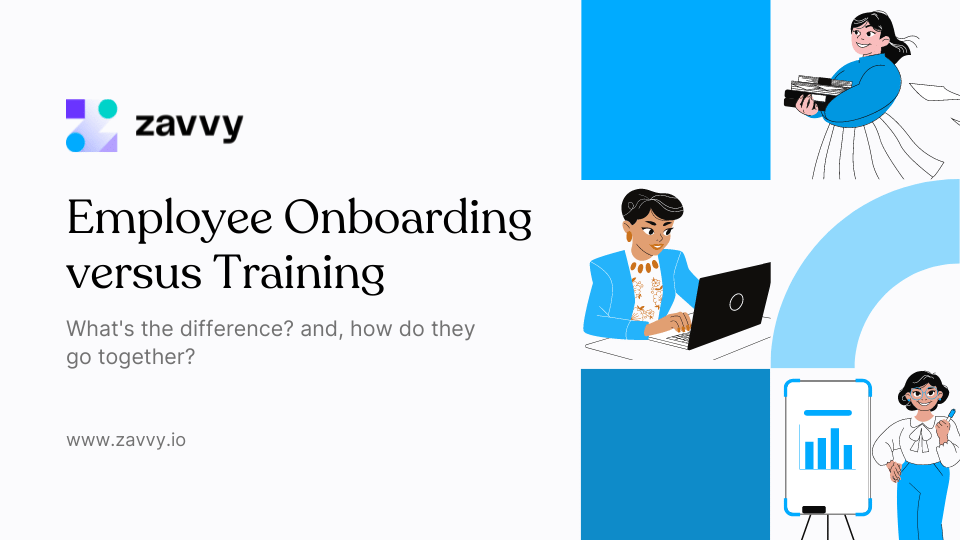
Welcoming a new member to the team is a crucial time for any workplace. You want to make the perfect first impression on the recruit. It's like making a pitch, but instead of pitching to investors, you're doing it to entice employees who want to join your organization.
It also happens to be a very sensitive period because one wrong move can interfere with the induction. Unfortunately, not many businesses understand the power of an optimized onboarding process. As a result, 33% of new hires start looking for a new job 6 months after they get hired, and 23% of them don't last an entire year.
Join us as we give you a comprehensive review of onboarding and training processes, what happens at each stage, and how they complement each other.
Together with our curators, we have created a library of actionable digital marketing resources. Personalized to your team's needs.
Employee onboarding refers to the process of welcoming new employees into their position at your organization. It comprises several phases, including:
Onboarding typically begins after new hires sign their paperwork. It allows them to meet their colleagues and better grasp the company's values and culture. Besides, onboarding helps create a positive first impression on the new hire. It's like an initiation process or rite of passage that prepares them before joining your organization.
Companies carry out employee onboarding because it improves engagement. Employees who go through comprehensive onboarding programs are more likely to be productive than those who don't.
It also allows new employees to learn and adapt to the workplace values, culture, and strategic vision. In addition, they get an opportunity to interact with their colleagues and develop good working relationships.
The initial stage of the induction process starts immediately after the recruits accept the job offer and sign the contract. At this stage, many companies make the mistake of leaving people entirely alone for months. We recommend at least sending them an introductory video or email to bridge the gap - e.g., detailing what their first day will entail.
This period allows for preparation ― maybe they're moving to a new location. Preboarding is the best time to sign all the necessary paperwork – a process that can be frustrating if not done in time. We recommend HR to create a checklist for all the documents to help prevent any errors.
This is a team effort ― everyone comes to meet and get acquainted with the new employee. Meeting new people, especially in a large organization, can be overwhelming. So it would be best to keep the process short and simple.
Orientation is the best time to:
The third stage of the onboarding process involves training the recruit on their new role. The HR or Learning and Development department usually conducts this process, depending on the company's organizational structure.
It equips the new employee with the skills and confidence to carry out their responsibilities. There are several ways to carry out training; they include
The new employee has gotten more used to the routine and is transitioning into a more permanent role. This period lasts anywhere between three to six months. Frequent check-ins are crucial as they allow the supervisor to gauge how effective the onboarding process is.
Here, the recruit has fully acclimatized and can now begin making long-term plans such as:
Spoiler: This one comes quite close to our definition of "training".
Small companies prefer to leave the onboarding process to the HR department. However, the roles tend to vary across various companies. It primarily depends on the organization's structure, employees, and work culture.
Other firms rely on the recruiting manager to head the onboarding process. Usually, the learning and development department takes over the role. To add to that, some companies prefer hiring a professional onboarding manager to take the recruit through the induction process.
Employee training refers to the process of teaching an employee the inner workings of the company - and especially the role. It's a part of the overall onboarding process―although it comes at a much later stage.
Employee training begins a few weeks after the new employee has acclimatized to the new environment and gotten the hang of things. It usually takes a few weeks up to six months.
Naturally, the recruit might have a bit of trouble getting used to the new systems; that's why companies use onboarding training. Not only does it streamline the process, but it also quickens the rate at which the recruit acclimatizes.
A training program is essential for productivity. A recruit who undergoes training is more likely to be productive than one who doesn't. That's because training allows them to hit the ground running.
Why should you prioritize onboarding training for new employees? First, training teaches them the skills and knowledge required for their role, ensuring a boost in productivity and employee engagement. The new hire can then fully utilize their skills to maximize their potential.
Another reason why companies carry out employee training is to minimize job dissatisfaction. Starting a new job can be nerve-racking, especially when you don't fully understand what's required of you.
So training minimizes the anxiety and frustration by teaching recruits everything needed to function at 100%. Other reasons include:
The role of employee training programs largely depends on the organization's size. In smaller companies, it's usually owned by the HR team - and coordinated with people management.
With increasing company size and additional sub-departments within people ops, onboarding mostly sits within learning and development. Sometimes, however, recruiters feel particularly responsible for it as a crucial part of the candidate experience.
And sometimes you see ops, dedicated onboarding, or employee experience teams that have the strongest focus on this crucial period of them all.
Onboarding refers to the induction of a new employee to a company. The process typically contains five stages and begins immediately after the recruit signs their contract.
Ideally, onboarding lasts for a few months after the employee begins working at total capacity.
Onboarding is vital for the seamless integration of a new member to an organization. It provides them with the necessary knowledge and skills to help them fit into their new role. It's also essential for productivity and increases employee retention rates.
On the other hand, training refers to providing education to new hires. It's a continuous process that goes on long after they begin their new job. Training keeps the employees updated on the emerging trends and skills for their particular role.
Think of it like this; onboarding is a process that gets kicked off once, with a clear start and a clear end (usually sometime around the end of probation).
Training is the continuous process of developing one's skills.
There's an intersection between the two: Honing role-related skills within onboarding can also be seen as training.
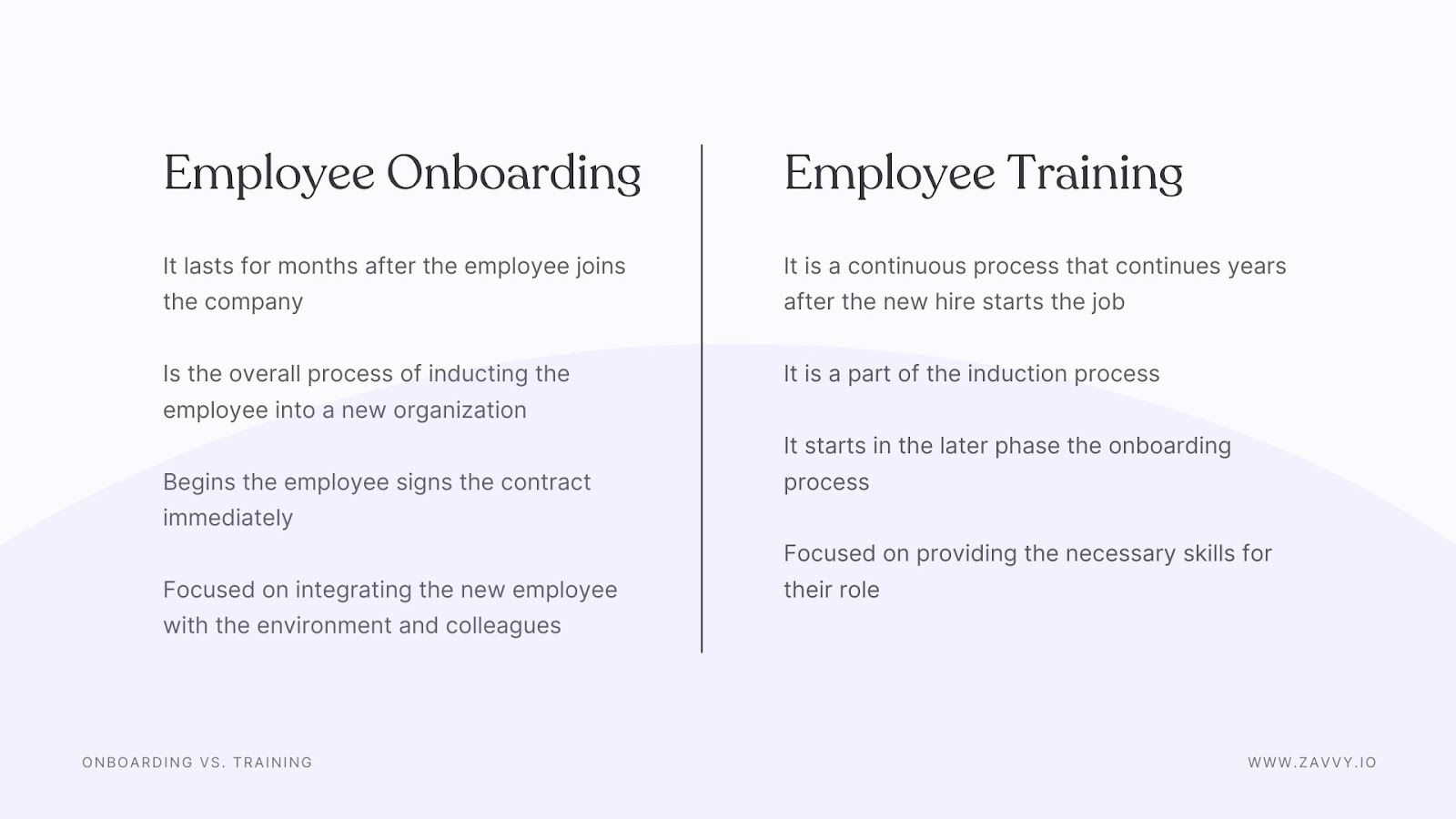
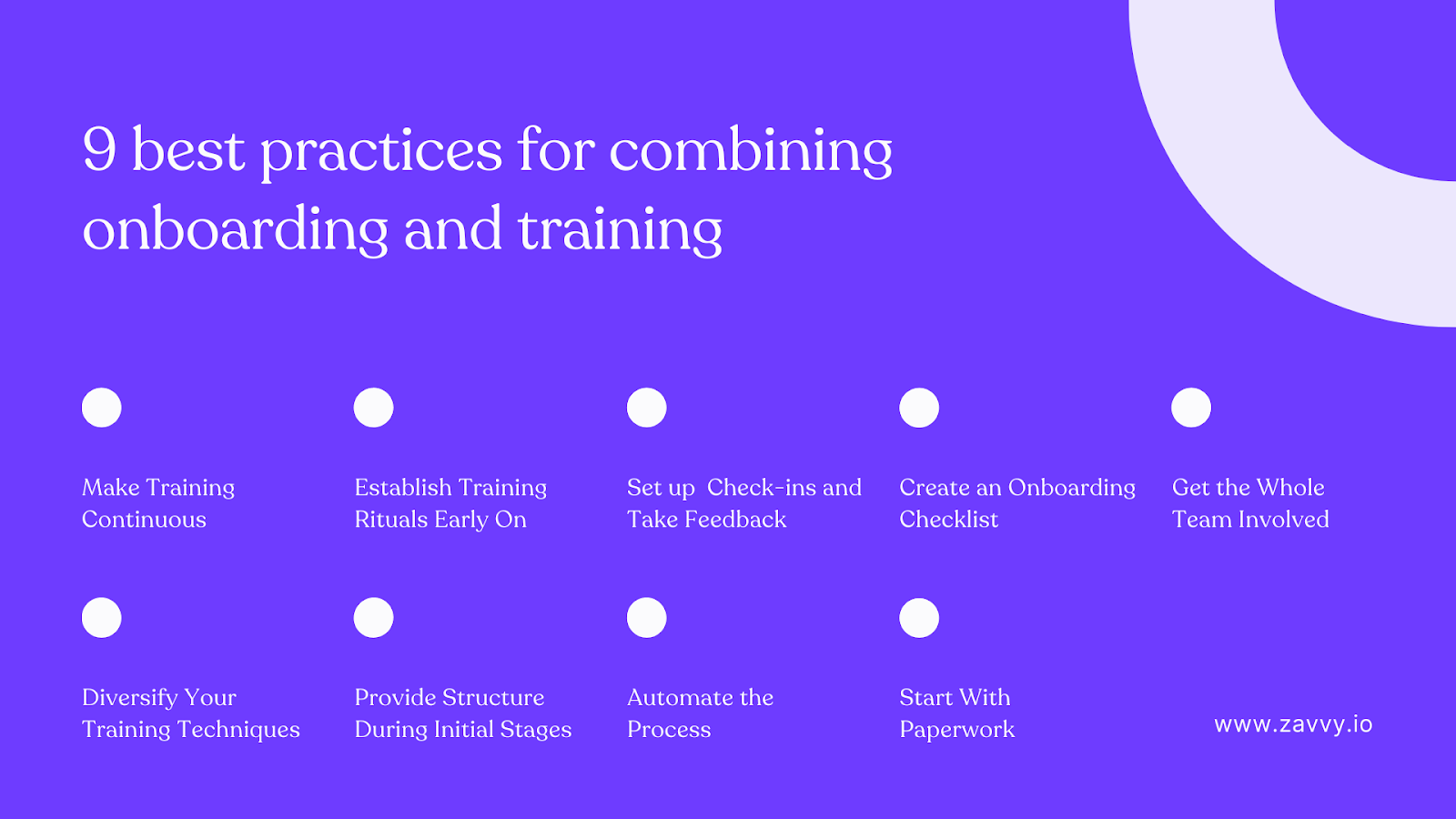
Make training a continuous process by introducing a learning culture into your organization. The Learning and Development department can develop opportunities for employees such as
The best time to begin training is immediately after orientation. This is because the employees are more likely to retain habits when they establish them from the start.
Feedback is vital for both onboarding and training. You'll want the new employee to acclimatize without any challenges. Set up a schedule either weekly or every two weeks where the new employee reports back to the supervisor.
Zavvy's Slack integration lets you automate the feedback process by sending reminders and pulse surveys on auto-pilot.
Frequent check-ins allow you to address any potential concerns for a smoother experience.
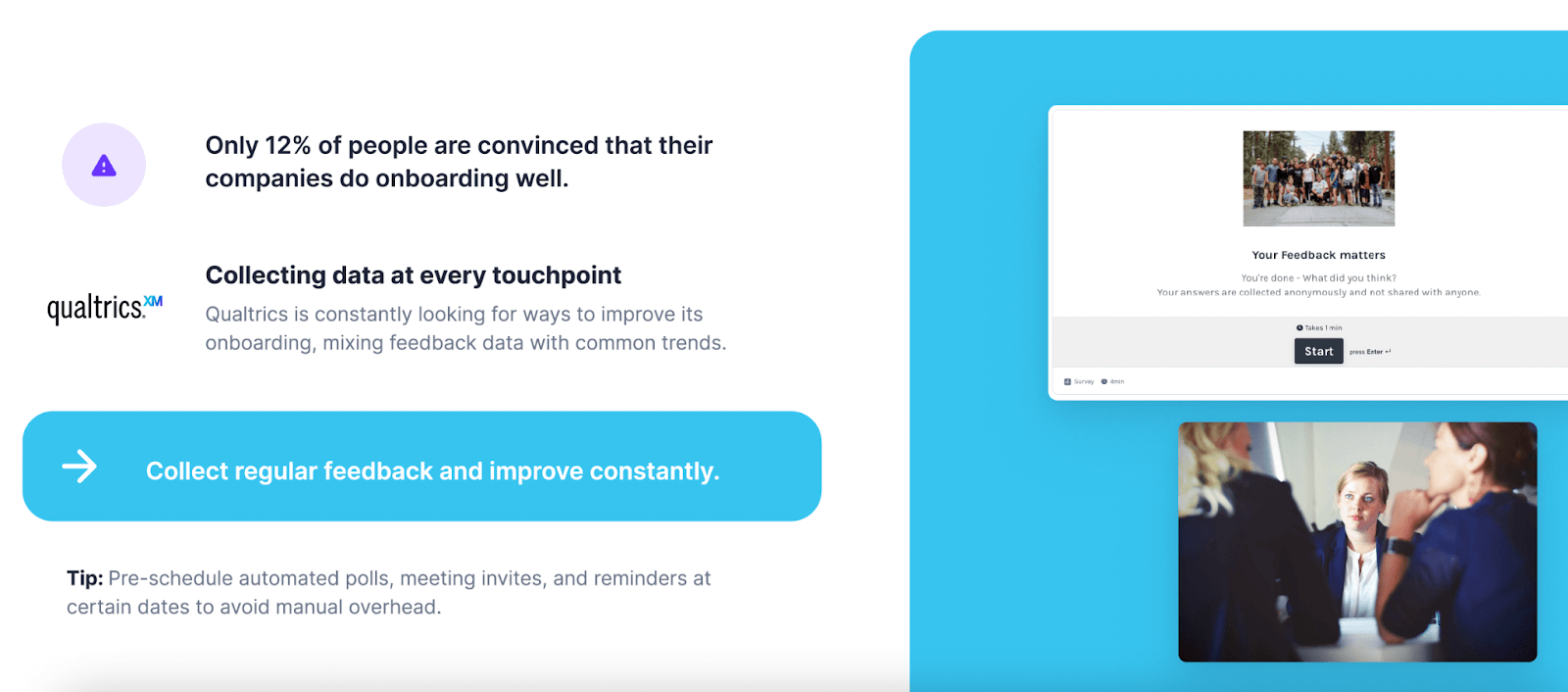
Think of an onboarding checklist as a to-do list. Create a Google Doc with checkboxes with all the steps and processes required for the whole operation. Then, make sure you share it with the recruit and supervisor for maximum transparency.
This way, you'll make sure not to forget anything and create a structured + consistent experience.
Induction and onboarding are typically a team affair. You want the new hires to get comfortable around their colleagues and the organization. (Virtual) company events are a great way to socialize the recruit with the rest of the personnel.
If you're hungry for more innovative ideas, we've gathered 17 exciting ways to make onboarding fun. Have a look to build a great team culture from day 1.
Alternatively, you could create onboarding traditions for welcoming new employees. For instance, integrating our Meetup Ritual automation bridges the gap between your recruit and the rest of your team by setting up coffee dates or company-sponsored lunches.
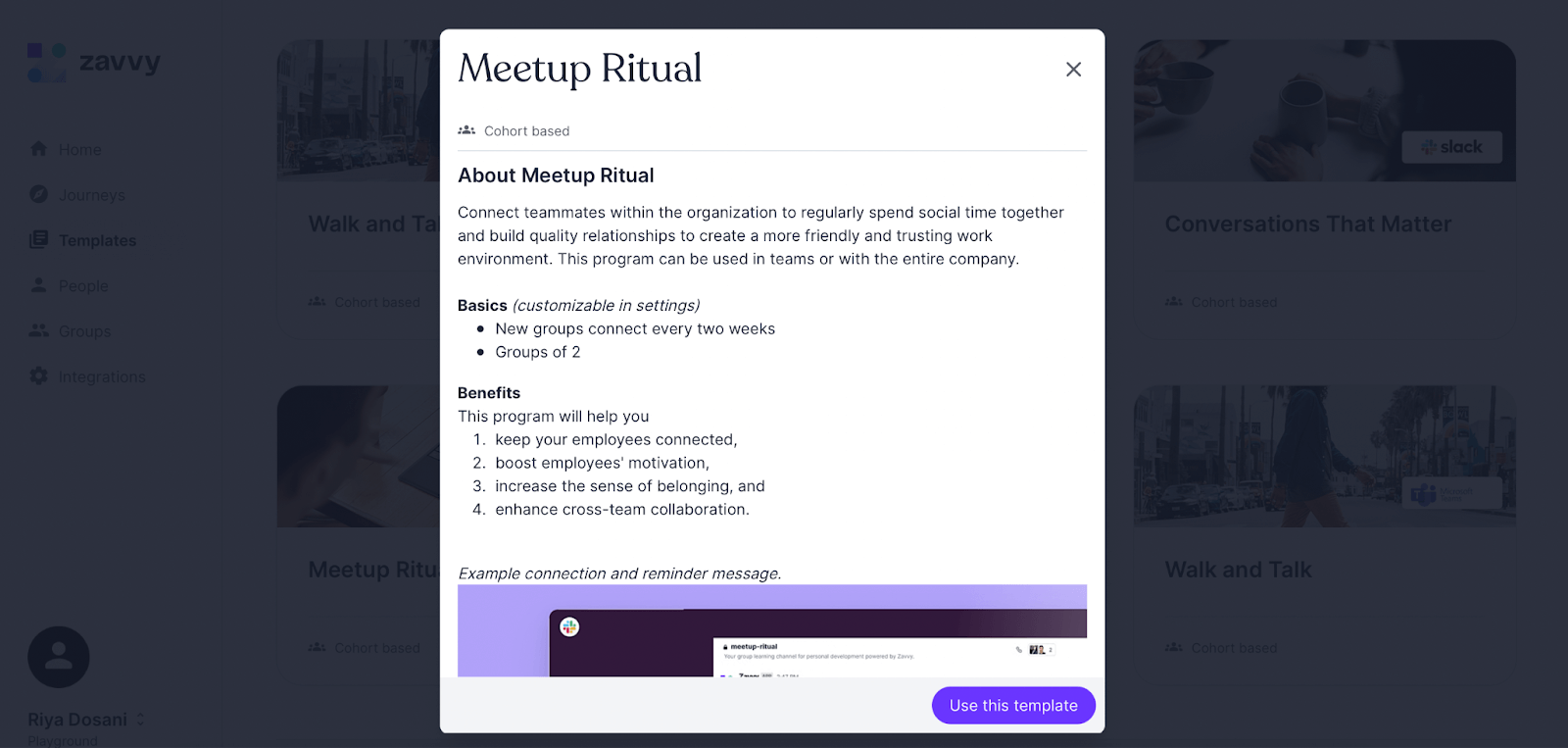
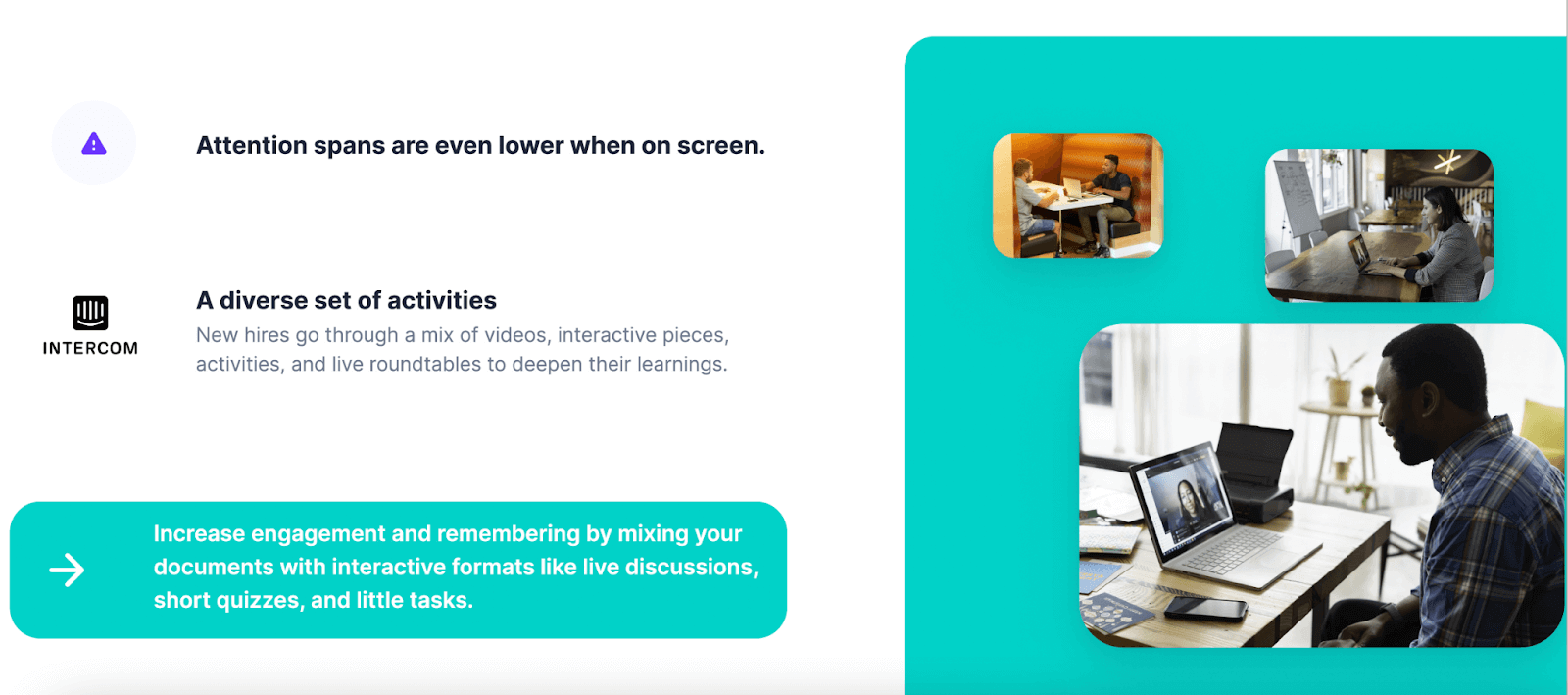
There are countless different methods you can use for training. Online-based learning is one good example. It's convenient, easily accessible, and caters to everyone–even the remote employees.
We've gathered some rather innovative employee development methods to add some inspiration.
The idea is to provide as much structure as possible to the new employee during the initial stages. That way, it sets a precedent for what's expected of them. It'll also help them adapt to the new environment faster.
The more engaged your employees are during the onboarding process, the more productive they will be. Giving them a sense of structure builds their confidence and helps soothe any "new-guy jitters."
Ways to deliver a structured onboarding process:
Running fully fledged, rich and welcoming onboarding and training initiatives can entail quite some manual effort. Here are a few tips to automate parts of the onboarding process from the minute an employee joins your company. So your new hire can focus on building connections with their colleagues rather than being bogged down by unnecessary paperwork. An onboarding software like Zavvy's even lets you automate everything - from user invitations to buddy programs.
The quicker you file all the necessary paperwork, the sooner your new hire can begin. This stage is critical because mistakes are bound to happen.
It could be anything from incorrect PINs or misspelled names. We recommend starting this process immediately after the recruit signs their formal contract.
While onboarding is an overarching process of integrating new hires into your organization, training is an essential part of it. Employee training is customized to each employee's role–equipping them with skills they need to perform at their best. For example, you might offer exclusive coding classes to a junior software developer. Or sign up your product manager for a boot camp course to gather some basic tech knowledge.
The goal isn't solely to train your people and leave them be. Instead, you need to give them a reason to believe in your company, the offering, and most importantly - motivate them. This is done during the onboarding process by delivering structured information, supporting your employees' growth, and enhancing their experiences.
Our employee enablement platform is your first step towards enabling your people to succeed in their roles and profoundly involving them in your organizational processes. Connect with our experts for a free demo or a consultation!
Below, we've gathered a few key terms related to both, so you will always be able to join the conversation.
Induction refers to the process of familiarizing a new employee with their role and organization.
This is the process of providing an employee with additional skills to improve their performance.
It is also known as re-onboarding and refers to the process of inducting, orientating, and training an employee after an extended absence.
After the pandemic, reboarding has also become an issue for companies returning to in-office work.
Why?
It's the process that entails severing professional ties between a company and its employee once they leave the organization.
Before an employee starts their job - right after signing their employment contract.
Upskill your team every week with the best contents and personalized recommendations.

Welcoming a new member to the team is a crucial time for any workplace. You want to make the perfect first impression on the recruit. It's like making a pitch, but instead of pitching to investors, you're doing it to entice employees who want to join your organization.
It also happens to be a very sensitive period because one wrong move can interfere with the induction. Unfortunately, not many businesses understand the power of an optimized onboarding process. As a result, 33% of new hires start looking for a new job 6 months after they get hired, and 23% of them don't last an entire year.
Join us as we give you a comprehensive review of onboarding and training processes, what happens at each stage, and how they complement each other.
Get a demo!
We'll be happy to show you around and answer all your questions.
Trusted by innovative companies



We'll be happy to show you around, answer your questions, or arrange a free trial.
Erhalten Sie eine kostenlose Demo unserer Onboarding-Software.
Vertraut von



Your Training & Development Strategy - Solved in 1 Tool.
Trusted by innovative companies



We'll be happy to show you around, answer your questions, or arrange a free trial.
Learn how Zavvy helps you drive performance, development, and engagement.
Trusted by innovative companies



We'll be happy to show you around, answer your questions, or arrange a free trial.
We'll be happy to show you around and answer all your questions.
Trusted by innovative companies



We'll be happy to show you around, answer your questions, or arrange a free trial.
Gerne zeigen wir Ihnen ganz unverbindlich unsere Plattform im Detail.
Vertraut von modernen Unternehmen



Get a demo!
We'll be happy to show you around and answer all your questions.
Trusted by innovative companies



We'll be happy to show you around, answer your questions, or arrange a free trial.
Erhalten Sie eine kostenlose Demo unserer Software für Mitarbeiterenwicklung und Training.
Moderne Unternehmen
setzen auf Zavvy


